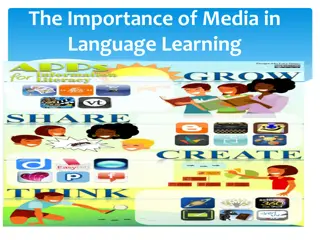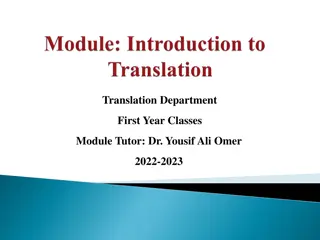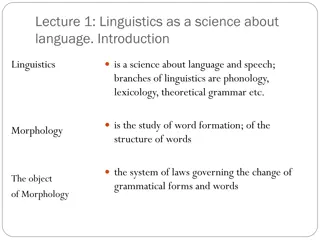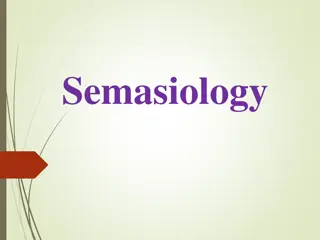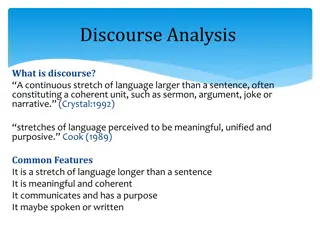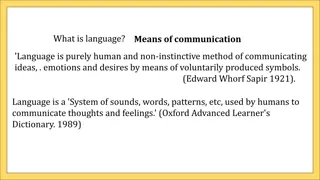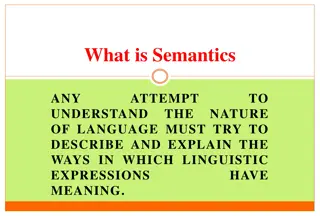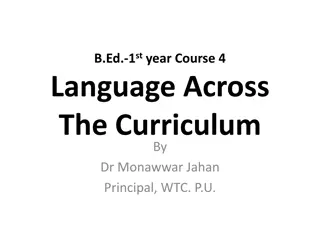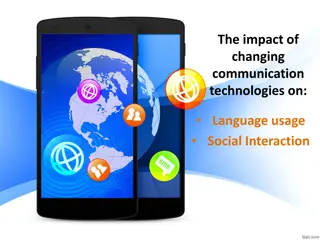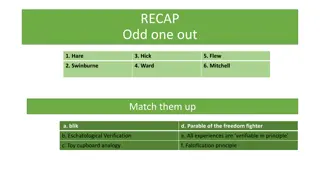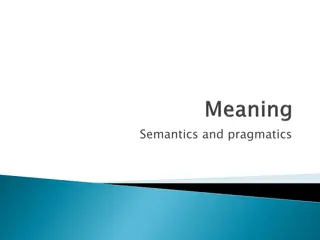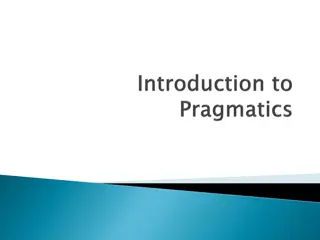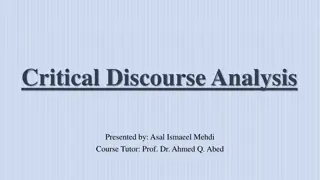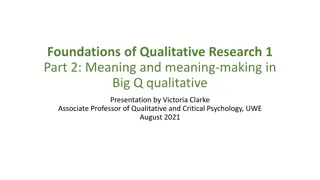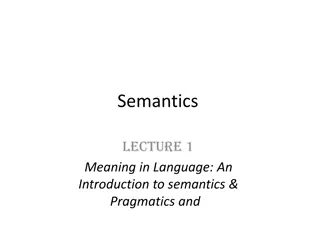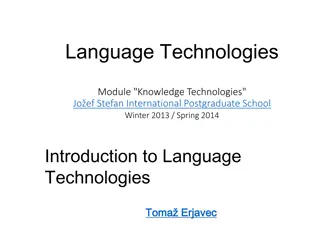LANGUAGE-- --MEANING
Explore the levels of meaning in language from literal to pragmatic interpretations, examining how cognitive psychology principles apply to understanding the complexities of language comprehension and representation.
Download Presentation

Please find below an Image/Link to download the presentation.
The content on the website is provided AS IS for your information and personal use only. It may not be sold, licensed, or shared on other websites without obtaining consent from the author.If you encounter any issues during the download, it is possible that the publisher has removed the file from their server.
You are allowed to download the files provided on this website for personal or commercial use, subject to the condition that they are used lawfully. All files are the property of their respective owners.
The content on the website is provided AS IS for your information and personal use only. It may not be sold, licensed, or shared on other websites without obtaining consent from the author.
E N D
Presentation Transcript
Langston, PSY 4040 Cognitive Psychology Notes 12 LANGUAGE LANGUAGE-- --MEANING MEANING
Where We Are We re continuing with higher cognition. We still have: Language Meaning Reasoning/Decision making Human factors
Plan of Attack The last unit was more about the structure of language. This time we ll look at meaning. Our goal is to see how cognitive psychology basics can be brought to bear on an applied problem: Levels of representation of meaning (mostly individual sentences). How to combine the meanings of sentences into larger texts.
Levels of Meaning Literal: What the sentence actually says (as close as possible to the exact words). Inference: Beyond literal to fill in missing parts that aid comprehension. Figurative: The intended meaning is different from the words used. Pragmatic: The words don t convey the meaning.
Literal Meaning One possibility is verbatim meaning (the exact words). Unlikely: Think of examples of things that you have learned word for word. What do they mean? You usually have to repeat them to answer that. There is evidence that verbatim representations are the fall-back strategy when other comprehension methods are not available.
Literal Meaning Mani & Johnson-Laird (1982): Provided determinate descriptions of arrangements: A is behind D A is to the left of B C is to the right of B Determinate descriptions were specific and described an arrangement that could be imagined (modeled).
Literal Meaning Mani & Johnson-Laird (1982): There were also indeterminate descriptions of arrangements: A is behind D A is to the left of B C is to the right of A Indeterminate descriptions were not specific and described an arrangement that would have to be represented with more than one possible model.
Literal Meaning Mani & Johnson-Laird (1982): Participants remembered the meaning of the determinate descriptions very much better (p. 183). Verbatim memory was only better for indeterminate descriptions. It looks like, in the absence of a coherent representation, participants fall back on trying to remember the exact words.
Literal Meaning Evidence against verbatim: Sachs (1967): Participants heard passages (e.g., about the telescope). At some point, they were asked if a sentence was identical to one in the passage.
Literal Meaning Evidence against verbatim: Sachs (1967): He sent a letter about it to Galileo, the great Italian scientist. (original) He sent Galileo, the great Italian scientist, a letter about it. A letter about it was sent to Galileo, the great Italian scientist. Galileo, the great Italian scientist, sent him a letter about it.
Literal Meaning Evidence against verbatim: Sachs (1967): Participants were asked either 0, 80, or 160 syllables later in the passage. The results were that the original form of the sentence (verbatim) was only available long enough to get the meaning. After even 80 syllables the second two appeared to participants to be the same as the original (the last one changed the meaning, so it wasn t confusable). This argues against verbatim.
Literal Meaning Another way to think about literal meaning is to use propositions. Kintsch, W. (1972). Notes on the structure of semantic memory. In E. Tulving & W. Donaldson (Eds.), Organization of memory (pp. 247-308). New York: Academic Press.
Literal Meaning A proposition can be thought of as a single idea from a segment of text. For example (p. 255) The old man drinks mint juleps is really two sentences, one embedded in the other: The man drinks mint juleps. The man is old. This would produce two propositions.
Literal Meaning A proposition is a relation plus some arguments. Kinds of relations (p. 254-255): Verbs The dog barks. (BARK, DOG) Adjectives The old man. (OLD, MAN) Conjunctions The stars are bright because of the clear night. (BECAUSE, (BRIGHT, STARS), (CLEAR, NIGHT))
Literal Meaning Kinds of relations (p. 254-255): Nouns (nominal propositions) A collie is a dog. (DOG, COLLIE) Arguments are usually nouns, but can be whole propositions. Example: The old man drinks mint juleps. (DRINK, MAN, MINT JULEPS) (OLD, MAN)
Literal Meaning What propositions are in this sentence? The professor delivers the exciting lecture.
Literal Meaning What propositions are in this sentence? The professor delivers the exciting lecture. (DELIVER, PROFESSOR, LECTURE) (EXCITING, LECTURE)
Literal Meaning Evidence for propositions: Kintsch (1972) provided some data to support propositions. Participants wrote all the clear implications they could think of for sentences like Fred was murdered. They did not write things that were merely possible.
Literal Meaning Evidence for propositions: Kintsch (1972) found that inferences supported aspects of the proposition theory. For example, for Fred was murdered, most participants said the agent case was necessary (e.g., someone murdered Fred).
Inferences From Singer (1994): Androclus, the slave of a Roman consul stationed in Africa, ran away from his brutal master and after days of weary wandering in the desert, took refuge in a secluded cave. One day to his horror, he found a huge lion at the entrance to the cave. He noticed, however, that the beast had a foot wound and was limping and moaning. Androclus, recovering from his initial fright, plucked up enough courage to examine the lion s paw, from which he prised out a large splinter (Gilbert, 1970) (p.479).
Inferences Singer (1994): How many inferences can you find?
Inferences Singer (1994): How many inferences can you find? Wound is an injury and not the past tense of wind. Who is he? Instrument used to remove the splinter. Causal: Why moaning?
Inferences It is usually necessary for the listener/reader to fill in missing text information to make sense of what is being presented. Diane wanted to lose some weight. She went to the garage to find her bike.
Inferences It is usually necessary for the listener/reader to fill in missing text information to make sense of what is being presented. Diane wanted to lose some weight. She went to the garage to find her bike. Inference: Riding a bike is a way to lose weight.
Inferences Inferences could be propositions not explicitly mentioned (e.g., agents or instruments). Inferences could be features of things activated during comprehension.
Inferences As part of the ecological survey approach, let s consider dimensions along which inferences can be classified (loosely based on Singer, 1994). Logical vs. pragmatic. Logical inferences are true if you make them. Phil has three apples. He gave one apple to Mary. Pragmatic inferences are some degree of likely: Mary dropped the eggs.
Inferences Logical vs. pragmatic. Logical could be more likely since they re certain to be true. That is not the case.
Inferences Forward vs. backward. Forward are also called elaborative. Made in advance. Seymour carves the turkey. Knife (Kintsch, 1972). Technically, forward inferences are not necessary to maintain comprehension. Backward are also called bridging. Diane passage. Why did she go to the garage and get her bike? Probably needed for comprehension.
Inferences Forward vs. backward. Elaborative way less likely to occur (e.g., Corbett & Dosher, 1978; doi 10.1016/S0022- 5371(78)90292-X).
Inferences Forward vs. backward. The dentist pulled the tooth painlessly. The patient liked the new method. (explicit) The tooth was pulled painlessly. The dentist used a new method. (bridging) The tooth was pulled painlessly. The patient liked the new method. (elaborative) (Singer, 1994)
Inferences Forward vs. backward. Explicit and bridging both led to faster verification of: A dentist pulled the tooth. True for agents, patients, and instruments.
Inferences Inference type: Case-filling. Kintsch (1972) listed six cases from Fillmore s (1968) case grammar: Agent (A): the animate instigator of a verb action. Instrument (I): an object causally involved in the verb. Experiencer (E): animate being affected by the verb. Result (R): object resulting from the verb. Locative (L): object identifying location or orientation of the verb. Object (O): noun whose role is identified by the meaning of the verb.
Inferences Inference type: Case-filling. Examples of cases: The entrance (O) was blocked by the chair (I). The house (R) in the mountains (L) was built by John (A). John (A) gave Jane (E) a book (O). John (E) received a book (O) from Jane (A). Many of Kintsch s (1972) inferences drawn by his participants were case filling.
Inferences Inference type: Event structure: Fill in causes, effects, etc. The actress fell from the 14th floor balcony.
Inferences Inference type: Lots of research on causal inferences (e.g., Myers, Shinjo, & Duffy, 1987): Tony s friend suddenly pushed him into a pond. Tony met his friend near a pond in the park. Tony sat under a tree reading a good book. He walked home, soaking wet, to change his clothes.
Inferences Inference type: Myers, Shinjo, & Duffy (1987): The difficulty of forming the bridging inference affected reading time. Difficulty was a function of causal relatedness.
Inferences Inference type: Parts: Carol entered the room. The X was dirty. You could infer that the room has an X. Script/schema: Scripts are knowledge of a particular action sequence (e.g., going to a restaurant). Schemas are compiled knowledge structures (e.g., you are building a cognitive psychology schema).
Inferences Inference type: Spatial/temporal: If you think back to Mani and Johnson-Laird (1982), spatial models constructed from text could allow inferences from the model.
Inferences Implicational probability: How strongly the inference is implied by the text.
Figurative The basic issue is that this kind of language has words that differ from the intended meaning. We will consider a variety of types.
Figurative Metaphor: a figure of speech in which a word or a phrase literally denoting one kind of object or idea is used in place of another to suggest a likeness or analogy between them (Kruglanski, Crenshaw, Post, & Victoroff, 2007; Direct link to the pdf).
Figurative Metaphor: How much? Is it poetic and fancy or is it common? Gibbs (1994): Ubiquitous. A lot of what appears to be literal is actually figurative (pp. 414-415): Your claims are indefensible. I ve never won an argument with him. You re wasting time. This gadget will save you hours.
Figurative Metaphor: Gibbs (1994): Ubiquitous. A lot of what appears to be literal is actually figurative. ARGUMENT IS WAR TIME IS MONEY (Lakoff & Johnson, 1980) Some of the confusion comes from the idea that conventional metaphors are necessarily dead and not figurative any more (like kick the bucket).
Figurative Metaphor: Gibbs (1994): Ubiquitous. Entire domains of cognition (like event structure) appear to have a metaphorical foundation (Lakoff, 1990): IMPEDIMENTS TO ACTION ARE IMPEDIMENTS TO MOTION - We hit a roadblock. AIDS TO ACTION ARE AIDS TO MOTION - It s all downhill from here.
Figurative Metaphor: Gibbs (1994): Ubiquitous. Metaphorical communication: Conduit metaphor: Ideas or thoughts are objects. Words and sentences are containers for these objects. Communication consists in finding the right word container for your idea-object. (p. 417)
Figurative Metaphor: Gibbs (1994): Ubiquitous. Metaphorical communication: Conduit metaphor: - It s very hard to get that idea across in a hostile atmosphere. - Your real feelings are finally getting through to me. - It s a very difficult idea to put into words.
Figurative Metaphor: Gibbs (1994): Ubiquitous. Just count it up. 1.80 novel and 4.08 frozen metaphors per minute of discourse. In conversation for two hours per day would mean uttering 4.7 million novel and 21.4 million frozen metaphors in a lifetime. One unique metaphor for every 25 words.
Figurative Metaphor: How is it understood? Do you have to understand a literal meaning and then metaphor? Does it violate communication norms? Cacciari & Glucksberg (1994): How do you spot them? Syntactic difference? No. The old rock has become brittle with age. (Referring to a professor.)






